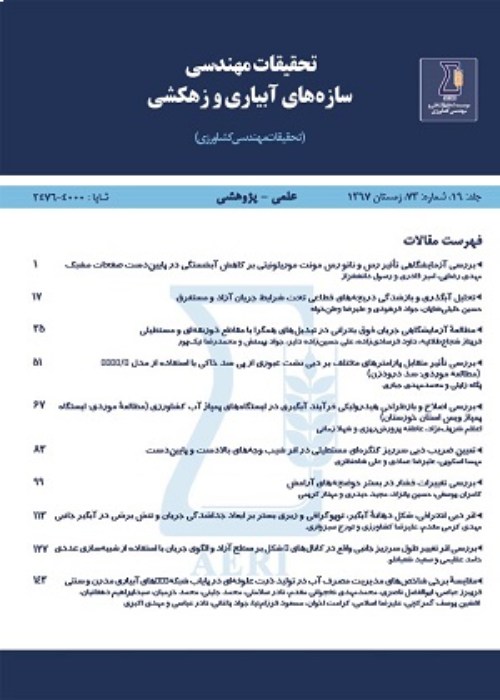Numerical Investigation of Density Current Hydraulic Parameters due to the Curvature of the Channel Body
Density difference causes density flow. Density flow is the the movement of the forehead, body, and tail of the heavy fluid into the ambient flow, and the buoyancy or gravity force causes the drive force. The movement of dense current under clear water creates a shear layer at the interface between clear water and density fluid. Therefore, at the interface, many cuts and vortices are created and this causes the entrainment of smooth water and density flow, which reduces the amount of density difference and the buoyancy force. Hosseini & Fattahi (2020) showed that the variations in the waterway shape causes higher velocity of density flow and decreases the flow thickness. Also, increasing the density of density flow, increases the maximum velocity in velocity profiles. This increase in the maximum velocity of the density flow is more pronounced in streams with higher inlet flow. The velocity profile patterns in the wall and jet area of the density flow body are influenced by the flow regime.
In this research, the density flow is illustrated in 3 different models according to Figure 1. The opening rate of the density flow valve is considered to be 1 cm. In this research, we have tried to show the effect of curvature at 180 ° bend and sinusoidal shape restricted channel and the flood plain. In this simulation the channel with 4 different longitudinal slopes, 0.002, 0.005, 0.008 and 0.02, are modeled and also 4 different densities, 0.00667, 0.00727, 0.00859 and 0.01 g / cm3, and 4 f Froude numbers, 1.2, 3, 5 and 8, have been used. Moreover six different mesh gridding for the flood plain and six different mish gridding for the channel are considered. it should be mentioned that 6 types of turbulence models ( The k-e model (standard, RNG, investigable), the kw model (standard, SST) and the RSM model (linear strain-pressure) are used.
Four types of networks were selected for finite channel with sinusoidal curvature. Figure (3) compares the different mesh gridding with the tested mesh and it was observed that in the range close to the bed, at high speeds, meshes with dimensions of 60 × 20 × 140 are very close to the experimental model developed by Hosseini & Fattahi (2020). Also, considering all 3 optimal models for turbulence models, k-ε models can be considered more optimal than k-ω and RSM models. The effects of the increasing slope of the flume bed in the wall area is more tangible than in the jet area while Froude number and input density are the same. On the other hand, increasing the slope of the channel bed from 0.2% to 2%, reduces the density flow thickness along the channel. As a result, the flow velocity shows an increase in the density flow which causes the growth of the drive force and will increase the turbulent flow velocity by increasing the inlet Froude number from 1.22 to 8. In all laboratory data, the density current concentration profile in the jet area shows a higher dispersion of 47% than the wall area. By increasing the slope of the channel from 0.2% to 2%, the dispersion rate increases by 65%. Richardson data and entrainment ratio in model No.1 increased by 10% compared to the experimental model and also these data increased by 19% in model No.2 compared to the experimental model.
In this research, we tried to simulate the three-dimensional density flow in models with 180 degree bend and limited sinusoidal curvature as well as sinusoidal patterns with plain flood. Also, the most optimal computational mesh, turbulence model, slope, density and Froude number are investigated as long as the studies include the depth profiles of velocity, density, turbulence, etc. in a situation where the channels are curved. Moreover, by increasing the number of Froude numbers from 1.22 to 8, due to model number 1 with 180 degree curvature, the pattern of density profile decreases by 19% and 21.3% compared to models number 2 and 3, respectively. Also, in all laboratory data, the density current concentration profile in the jet area shows a higher dispersion of 47% than the wall area. With increasing the slope of the channel from 0.2% to 2%, the dispersion rate increases by 65%. Richardson number has established a significant relationship with the entrainment ratio, which has a correlation of 0.71. Also the numerical entrainment ratio (for all three models) increased by 4.4% compared to the experimental model.AcknowledgmentsWe would like to thank Water and Hydraulic Laboratory of Shiraz University for their effective cooperation.
- حق عضویت دریافتی صرف حمایت از نشریات عضو و نگهداری، تکمیل و توسعه مگیران میشود.
- پرداخت حق اشتراک و دانلود مقالات اجازه بازنشر آن در سایر رسانههای چاپی و دیجیتال را به کاربر نمیدهد.


